
E.U.-NATO Task Force has recommended to strengthen its resilience and protection of critical infrastructure
The European Union (E.U.) – North Atlantic Treaty Organisation (NATO) Task Force has presented an assessment report which maps out the current security challenges and identifies 4 critical cross-cutting important sectors, including energy, transport, digital infrastructure and space.
The E.U.-NATO Task Force was launched on March 16, 2023, to prevent disruptions to critical infrastructure that provides essential services to citizens and supports the economies. This gained significance due to Russia’s invasion of Ukraine, which brought new risks, physical and cyber-attacks, often combined as a hybrid threat.
Taking it to twitter, the President of the European Commission – Ursula von der Leyen, tweeted, “I’m glad to present today with @jensstoltenberg the outcome of the joint EU-NATO Task Force on resilience of critical infrastructure. It identifies key security challenges in energy, transport, digital infrastructure & space. We will follow-up together on its recommendations.”
As per the E.U. – NATO Task Force’s report, the sabotage of the Nord Stream pipelines illustrated the vulnerability of energy infrastructure. Energy security is more challenging in the current geopolitical environment. Moreover, military activities significantly rely on civilian energy networks and supplies. Besides, the increased reliance on renewable energy also brings potential supply chain vulnerabilities since many of their critical components are still largely concentrated outside of NATO and the E.U.
In terms of transport, the assessment said that transport infrastructure, including airports and seaports, is also vulnerable to cyber-attacks, which can inflict substantial economic damage and possibly cause disruptions for use by the military. The military relies heavily on civil and commercial transport infrastructure to deploy their activities. Moreover, transport infrastructure is increasingly digitalised, making it more vulnerable to malicious cyber activities and disruptions.
Another area of concern is digital infrastructure. A wide range of infrastructure is required to provide information and communications services, from underground and undersea fibre-optic cables to cellular base stations and satellites. The reliance on undersea cables and 5G networks poses risks due to limited repair capabilities and increased vulnerability. Moreover, digital infrastructure relies on global supply chains. These are vulnerable to accidental and intentional disruptions, which could impact global networks and introduce security risks.
Space infrastructure encompasses both space-based assets and ground-based systems, which can be vulnerable to various human-induced and natural risks. Space assets can be owned and operated by the E.U., Member States, Allies and, increasingly, commercial entities. Strategic competitors and potential adversaries are developing counter-space capabilities that could threaten NATO and the E.U.’s access to and freedom of operation in space, potentially disrupting critical infrastructure.
The E.U.-NATO Task Force recommends increased engagement using synergies, strengthening the Structured Dialogue on Resilience and the Structured Dialogue on Military Mobility, promoting best practices, and assessments, and enhancing monitoring for security implications and cooperation.
Going ahead, the E.U. and NATO staff will take forward the recommendations of this report on the basis of long-standing cooperation and in full respect of the agreed guiding principles enshrined in the three Joint Declarations on E.U.-NATO cooperation. The EU-NATO Structured Dialogue on Resilience will ensure the coherence of the follow-up work of the Task Force.







